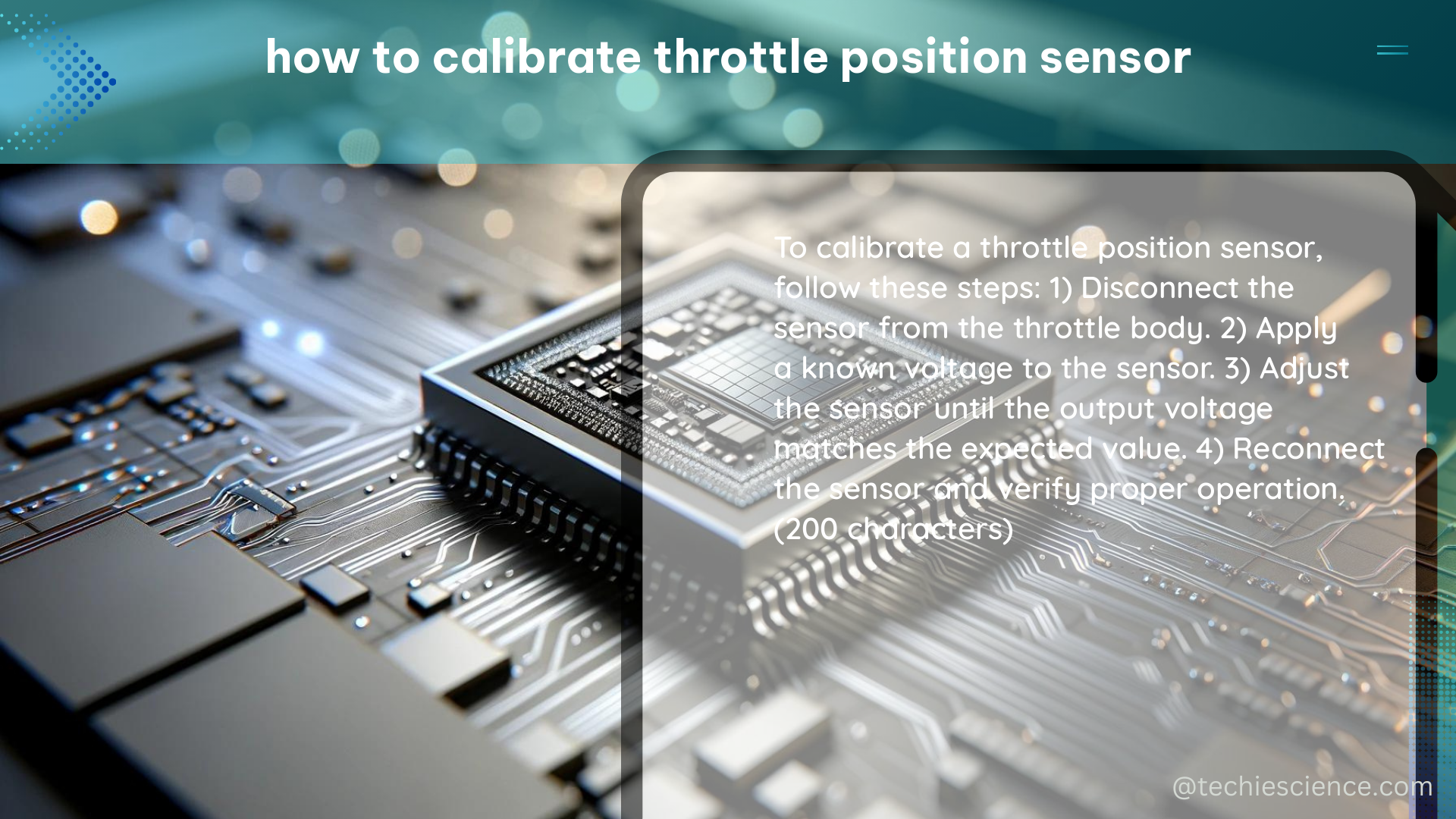The throttle position sensor (TPS) is a critical component in modern vehicles, responsible for providing the engine control unit (ECU) with accurate information about the throttle position. Proper calibration of the TPS is essential for ensuring optimal engine performance, fuel efficiency, and emissions control. This comprehensive guide will walk you through the step-by-step process of calibrating a throttle position sensor using a multimeter.
Understanding the Throttle Position Sensor
The TPS is a variable resistor potentiometer that measures the position of the throttle plate within the throttle body. As the throttle is opened, the resistance of the TPS changes, and this information is used by the ECU to determine the appropriate ignition timing, fuel injection, and other engine parameters.
The TPS typically has four terminals:
- E2 (Ground): This terminal is connected to the vehicle’s ground.
- VCC (Power): This terminal is connected to a 5V reference voltage from the ECU.
- SIG (Signal): This terminal provides the variable voltage signal to the ECU, representing the throttle position.
- IDL (Idle): This terminal is used to detect the idle position of the throttle.
Proper calibration of the TPS ensures that the ECU receives accurate information about the throttle position, allowing it to make the necessary adjustments to the engine’s operation.
Preparing for Throttle Position Sensor Calibration

Before you begin the calibration process, ensure that you have the following tools and materials:
- Multimeter: A digital multimeter (DMM) or an analog multimeter with ohm (Ω) measurement capability.
- Thickness gauge: A feeler gauge or a thickness gauge with a range of 0.4 mm (0.0157 in) or similar.
- Screwdriver: A set of screwdrivers to access the TPS and its mounting screws.
Additionally, make sure that the engine is at operating temperature and the throttle is in the fully closed position.
Step-by-Step Throttle Position Sensor Calibration
-
Access the TPS terminals: Locate the TPS on the vehicle and remove the plug connected to it. Connect the multimeter leads to the bottom two terminals (E2 and IDL) of the four TPS terminals.
-
Loosen the TPS mounting screws: Gently loosen the two TPS mounting screws, allowing the TPS to be turned clockwise or counterclockwise.
-
Adjust the TPS: Slowly adjust the TPS by turning the TPS body clockwise or counterclockwise until the multimeter reading is less than 2 Ohms.
-
Insert the thickness gauge: Insert the 0.4 mm (0.0157 in) thickness gauge between the throttle stop screw and the throttle lever.
-
Set the critical setpoint: Very slowly turn the TPS clockwise until the meter just switches from a less than 2 Ohm reading to an open circuit (infinity). This is the critical setpoint of the adjustment.
-
Repeat the adjustment: Repeat steps 2-5 until there is less than 2 Ohms between E2 and IDL with no gauge, and an open circuit (infinity) with the gauge.
-
Tighten the TPS mounting screws: Tighten the TPS mounting screws and re-verify the setpoint.
-
Reconnect the vehicle plug: Reconnect the vehicle plug that normally connects to the TPS.
It’s important to note that the car’s performance may vary with different setpoints, and experimentation in increments of 0.2 mm (0.0079 in) either clockwise or counterclockwise may be necessary to achieve the optimal results for your driving preferences.
Alternative Calibration Methods
In addition to the multimeter-based calibration method, there are other ways to calibrate the throttle position sensor:
Using a Digital Multimeter (DMM) or Scanner
- Connect the DMM or scanner to the TPS terminals and observe the voltage or resistance readings.
- Slowly open and close the throttle, noting the corresponding changes in voltage or resistance.
- The voltage or resistance should change smoothly and linearly as the throttle is operated.
- Adjust the TPS position until the voltage or resistance readings match the manufacturer’s specifications.
Using a Scan Tool
- Connect a scan tool to the vehicle’s diagnostic port.
- Navigate to the TPS data parameter and observe the readings.
- Slowly open and close the throttle, noting the corresponding changes in the TPS reading.
- Adjust the TPS position until the readings match the manufacturer’s specifications.
Regardless of the method used, it’s essential to ensure that the TPS calibration is accurate and consistent across the entire throttle range to maintain optimal engine performance and fuel efficiency.
Conclusion
Proper calibration of the throttle position sensor is a critical step in maintaining the overall health and performance of your vehicle. By following the step-by-step guide provided in this article, you can ensure that your TPS is accurately calibrated, leading to improved engine response, fuel economy, and emissions control. Remember to always refer to the manufacturer’s specifications and guidelines when performing any maintenance or repairs on your vehicle.
References
- How to Calibrate a Throttle Position Sensor with a Multi-Tester
- Royal Enfield Owners Club
- How Can You Calibrate Throttle Position?
- Throttle Position Sensor Calibration

The lambdageeks.com Core SME Team is a group of experienced subject matter experts from diverse scientific and technical fields including Physics, Chemistry, Technology,Electronics & Electrical Engineering, Automotive, Mechanical Engineering. Our team collaborates to create high-quality, well-researched articles on a wide range of science and technology topics for the lambdageeks.com website.
All Our Senior SME are having more than 7 Years of experience in the respective fields . They are either Working Industry Professionals or assocaited With different Universities. Refer Our Authors Page to get to know About our Core SMEs.